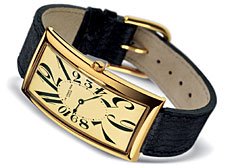
Tissot marks anniversary with pocket history

The Tissot watch company has found a novel way of celebrating its 150th anniversary.
It’s offering two million customers a pocket book exploring Tissot’s history and its close links with the Jura region.
“We don’t want to keep this anniversary to ourselves,” explains Tissot president François Thiébaud. “We wanted to involve our customers too, so we made them part of our history.”
The book, which runs to almost 300 pages, has been produced in eight languages.
Written by watch historian Estelle Fallet, it is a voyage of discovery with a fictional traveller, who on his way back to the bright lights of Paris from his holidays on the Côte d’Azur, stops off at the small and secluded town of Le Locle.
There, he discovers the Tissot watch factory, and the book delves into the company’s rich heritage in inventions and technology.
Landmarks
Tissot, now a member of the Swatch Group, has produced a number of watchmaking landmarks over the last century and a half.
They range from the two-time zone watch of 1853 to the highly technical T-Touch watch of today – the world’s first touch screen timepiece which features a chronograph, barometer, compass, thermometer, altitude and alarm.
Other milestones have included the “banana” watch of 1917, the antimagnetic watch of the 1930s and the pearl, wood and rock watches of the 1980s.
“Tissot is really a company that has taken the old art of making watches and has understood how to modernise continually,” the Swatch Group chairman, Nicolas Hayek, told swissinfo.
“Tissot was always present when some new type of watches were made. The T-Touch is a very good example of what Tissot is doing.”
Total spectrum
“At the same time, you can see mechanical watches that Tissot is producing, so they have been capable of really covering the total spectrum of the art of making watches,” he added.
Hayek believes that Tissot, which now sells an annual two million watches, has the potential in the coming years to sell between five and ten million timepieces, with the increase coming from Asian countries.
Despite these aspirations, Thiébaud told swissinfo that company strategy would remain the same.
“My strategy is to just keep doing the same we’ve done over the last 150 years. It’s going well, so why should I change?”
“We want to remain in the right price segment, which is in the middle range, and [focus on] quality,” he said.
To celebrate its 150 years of watch-making heritage, Tissot is also launching two commemorative limited edition automatic chronometer watches, inspired by one of its most prestigious timepieces created in 1946.
The company is this year also putting its watchmaking skills on show at two Swiss museums – the Château des Monts museum in Le Locle and the International Horology Museum in La Chaux-de-Fonds.
Smaller versions of the exhibitions will also tour the world.
swissinfo, Robert Brookes
The founder of the company in 1853 was Charles-Félicien Tissot, known as Daguette.
Tissot’s son, Charles-Emile, in 1858 took the brand to Russia, where the Savonette pocket watches proved very popular.
The company won a number of medals at European exhibitions. It took a Grand Prix at the 1900 Great Exhibition in Paris, where a Tissot watch was acquired by actress Sarah Bernhardt.
Other Tissot watch owners have included Carmen Miranda, Elvis Presley and Nelson Mandela.
Tissot is the official timekeeper for the world championships in cycling, motor cycling, fencing and ice hockey.

In compliance with the JTI standards
More: SWI swissinfo.ch certified by the Journalism Trust Initiative





























You can find an overview of ongoing debates with our journalists here . Please join us!
If you want to start a conversation about a topic raised in this article or want to report factual errors, email us at english@swissinfo.ch.